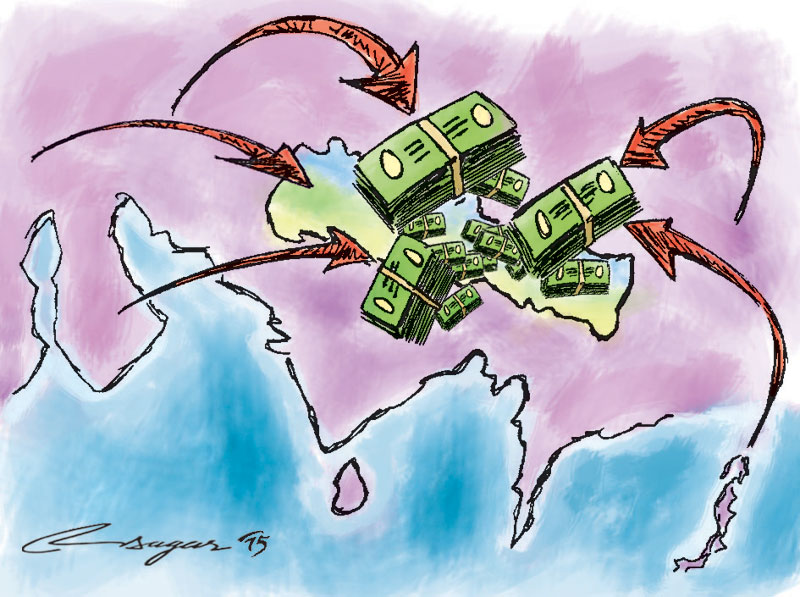Role of remittances: Reconstruction and recovery
Still, the inflow of remittances can support reconstruction in earthquake-affected Nepal, but it cannot sustainably be a replacement for investment and reconstruction
During the past decade developing countries have been increasingly exposed to natural disasters with severe consequences with respect to output, trade, and fiscal balances. Especially low income countries are highly vulnerable to natural disasters including earthquakes because of their limited ability to absorb large external shocks affecting the economy. These disasters hamper sustainable development initiatives and exacerbate other financial, health and environmental shocks. As a result, the policy debate is refocusing on these countries’ vulnerability. Given the precarious public budgetary stance, asset destruction caused by natural disasters could largely hamper capital accumulation and growth potential.
In this respect, external resources for post disaster reconstruction can be sourced from multilateral development banks, regional development banks, bilateral development partners, international NGOs, private philanthropies and charities, and remittances. Among these different resources, the role of remittances in reconstruction and recovery of earthquake-affected economies is briefly examined in this article as the dynamics of earthquake-induced remittance flows and the possibilities of leveraging remittances for post-earthquake development have been very meagerly researched so far.
Country experiences demonstrate that remittances can play a distinctive role in reconstruction and recovery programs of earthquake stricken countries. Literature reveals that migrant remittance flows increase in the aftermath of large earthquakes, and act as a safety net for households that have migrants abroad. Migrants transfer more funds during difficult times to assist their families and friends. In this light, the Sendai Framework for Disaster Risk Reduction 2015-2030 that was adopted at the Third United Nations World Conference on Disaster Risk Reduction, held from 14 to 18 March 2015 in Sendai, Japan has recognized migrants as germane community-level stakeholders in disaster risk reduction and has also acknowledged the value of migrants’ knowledge and skills in building community resilience.
Generally, after an earthquake strikes, almost all households experience loss of income arising from the destruction of productive assets, the loss of local jobs, the return of wage earners from overseas countries or the disruption of remittance flows. However, households whose livelihoods include remittances appear less vulnerable to the earthquake’s effects, and possess considerably more livelihood resilience. According to the World Bank, the rise in remittances makes up for 13 per cent of income losses in the year of the natural disaster and 28 per cent within four years; in contrast, increases in development assistance make up for approximately 26 per cent and 21 per cent, respectively, during a four-year period.
Though remittances rise in the aftermath of an earthquake, it cannot be outrightly concluded that these flows would be directed towards long-term projects. It should be remembered that remittances are inspired by altruism on the part of the people sending money home; hence, it is quite normal to expect that they go up when the earthquake strikes since households are in dire need.
Currently, remittances to GDP ratio of Nepal stands at almost 30 per cent, putting the country among the top three recipients in terms of size of the economy and shelving thousands of households from slithering back into poverty. The significance of remittances to the macro-economic development of the country is enhanced by their relative independence from economic cycles, making them more stable than private capital flows. As an immediate upshot of the great earthquake of 25 April 2015, there appeared to have been a large increase in remittance inflow to Nepal during the tenth month (mid-April to mid-May) and the eleventh month (mid-May to mid-June) of FY 2014/15. Remittances aggregating about Rs. 63 billion flowed into the country during each of those months compared to an average inflow of Rs. 47 billion in the earlier months. This surge has been attributed to migrant workers transferring money to rebuild their damaged houses after the quake.
Remittances can be an invaluable resource for post-earthquake reconstruction. The fact that, especially in the recovery and rebuilding process, remittances are generally spent on local goods and services, means that their impact is multiplied, providing a further incentive to restore them.
Policymakers in Nepal should better incorporate remittances as a formal means to hasten post-earthquake reconstruction and recovery. The continuation or restoration of remittance flows while other incomes and means of livelihood go down or only slowly recover are obviously critical to the recovery of households receiving these remittances. But, it is important that remittances do not become a substitute for structural development. There are other downsides to remittance-dependence, too. Still, the inflow of remittances can support reconstruction in earthquake-affected Nepal, but it cannot sustainably be a replacement for investment and reconstruction. Likewise, although remittances are an important mechanism to help families prepare and recover, the long-term financial sustainability of such a system needs to be further examined.
Dr. Pant is Director at Nepal Rastra Bank.






